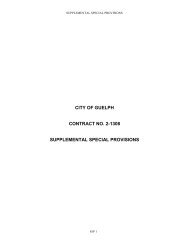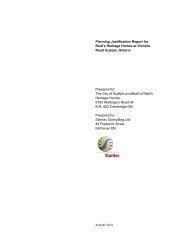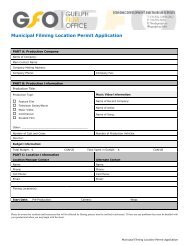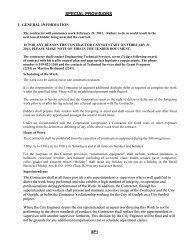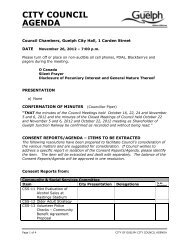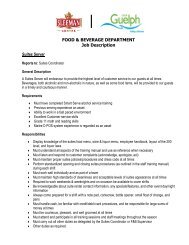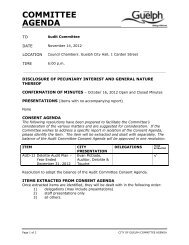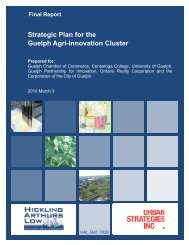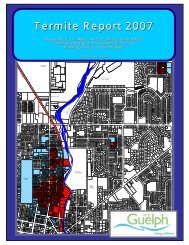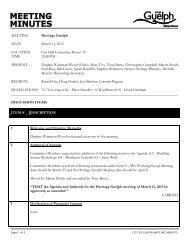AECOM Report B&W - N - City of Guelph
AECOM Report B&W - N - City of Guelph
AECOM Report B&W - N - City of Guelph
You also want an ePaper? Increase the reach of your titles
YUMPU automatically turns print PDFs into web optimized ePapers that Google loves.
<strong>City</strong> <strong>of</strong> <strong>Guelph</strong>2008 Annual <strong>Report</strong>Closed Eastview Road Landfill Siteperiods, such as in 2007. During drier periods, seasonal variability is generally between about 1.5 to 2 m inthe bedrock, however, in 2008, the variability was less than 1 m and, in most cases, around 0.5 m. As well,the shallow bedrock elevations were generally similar to or only slightly lower than those observed in 2006,which was also a very wet year.Further to the above, there are two monitoring locations (16 and 90), installed in 2003 that measure the deepbedrock aquifer water levels. Currently, there is still limited data (5 years) to assess long term trends in thedeeper bedrock, however, there is now sufficient levels to warrant looking at the short term trends. Initialwater levels that were collected from these locations were found to be variable. Although, there is onlylimited data (no historical levels), these initial variations appeared to be related to pumping <strong>of</strong> the municipalwells in the northeast quadrant. This was noted during 2004 when pumping was increased (within permittedrates) in the early part <strong>of</strong> the year when a corresponding decrease occurred. As well, when pumping was cutback, the water levels did increase into the summer. Water levels from this point began to decrease, similarto the normal seasonal decline observed, until the end <strong>of</strong> the year <strong>of</strong> 2004, even though there was areduction in pumping as well. A similar pattern was also noted in 2005 suggesting that although there issome effect from pumping, as expected, there is most likely a seasonal effect as well. Starting in 2006,water levels in the deeper bedrock exhibited a similar pattern as the seasonal trends observed in the shallowbedrock and overburden. Specifically, water levels increased from the late fall <strong>of</strong> 2005 into the spring <strong>of</strong>2006, followed by a slight decrease into early fall and then increasing again. As well, there was lessvariation during 2006 than observed in the previous two years. In 2007, a similar trend and decrease wasobserved in the deep bedrock as that observed in the overburden and shallow bedrock. Based on the shortterm data collected, it appears that the seasonal variability is between 2 to 2.5 m, which is slightly higherthan that observed in the shallow system. However, longer term data are still required to verify this. In 2008,a similar seasonal trend was also observed in that elevations increase from late 2007 into the spring <strong>of</strong> 2008.They decreased slightly into the late summer and then began increasing again to the fall. As with theshallow bedrock, there was less seasonal variability <strong>of</strong> only 1.5 to 2 m.It should be noted that the intent <strong>of</strong> these two deep bedrock monitors is to assess actual water level changeswith respect to current municipal pumping effects. With the short term data collected to date, there didappear to be a correlation with decreasing water levels with increase pumping. Once again this would not beunexpected. The overall extent <strong>of</strong> decrease needs to be better assessed over a longer term. In 2004 and2005, it was concluded that the landfill would not exceed reasonable use in the shallow bedrock beneath thewaste, when the preliminary water level data indicated higher variations in the deep bedrock. Therefore, along term water level database over the same pumping rate is required to better understand if theseobserved water levels changes occur under these normal pumping conditions.The shallow groundwater system is found in the sand and gravel outwash and/or in the upper part <strong>of</strong> the silty sandtill where outwash is absent 4 . Leachate elevations in monitors 51-IR and 59-I in the landfill waste are found to beperched above the shallow groundwater system and are not used in the evaluation. Figure 12 illustrates theshallow groundwater flows in June 2008. The groundwater flows are similar to previous years 5 .Of note, though, is the local control that the PLCCS exerts on the shallow groundwater flow system within thelandfill. As discussed previously in Section 3.4, the leachate collection system acts to lower leachate levelsinside the sheet pile wall below the groundwater levels outside the sheet pile wall, thereby creating inward4. The geology <strong>of</strong> the site has been extensively documented in previous reports; see 1995 Annual <strong>Report</strong> Section 4.2, pg. 385. 1995 Annual <strong>Report</strong>, Section 4.3, page 40, Figure 10, 1996 Annual <strong>Report</strong>, Section 4.2, page 45, Figure 17, 1997 Annual<strong>Report</strong> Section 4.2, Figure 13, 1998 Annual <strong>Report</strong>, Section 4.2, Figure 13. 1999 Annual <strong>Report</strong>, Section 4.2. Figure 13.(111414_2ra_apr29-09_city_<strong>of</strong>_guelph.doc) - 19 -



